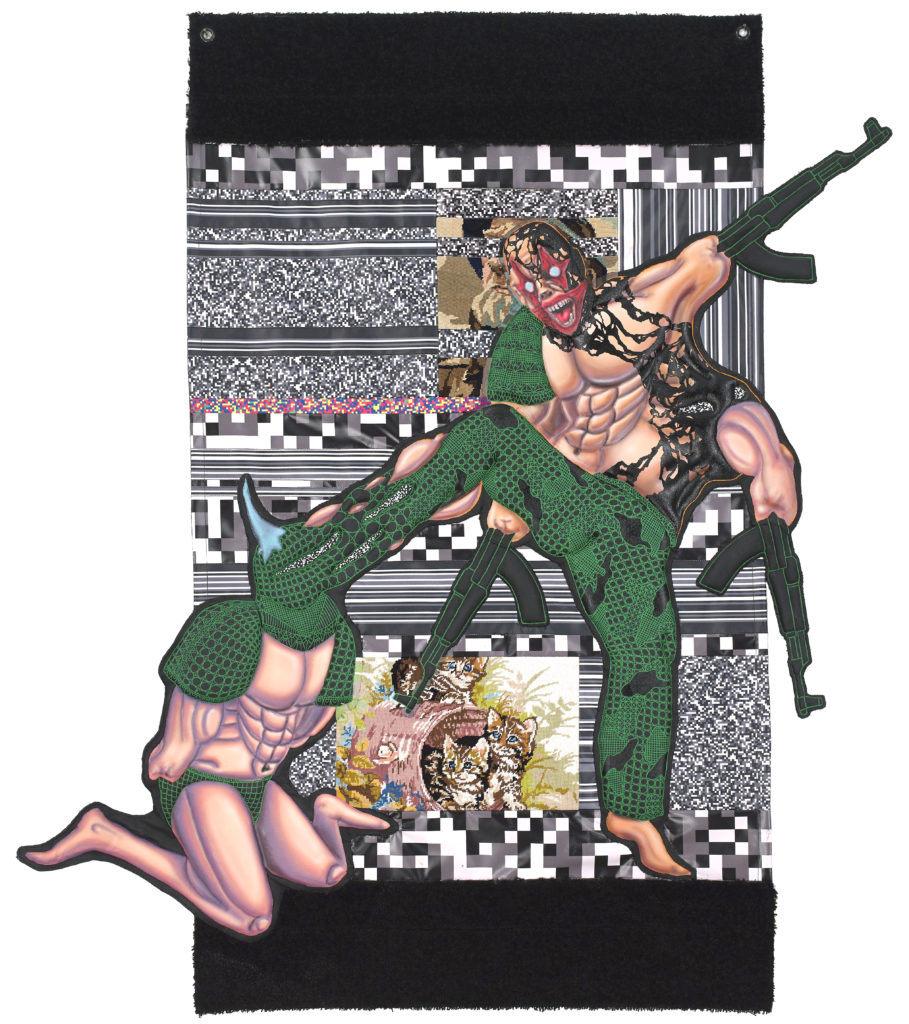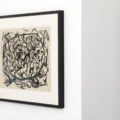Lucien Murat, avatars, eschatology and kitties

A being, one cannot decently see a man, crushes the face of a second kneeling before him. His muscles, especially his abdominals, are prominent, his glaze screams, and wounds around his eyes open it. His entire body is in the throes of terrible changes. His forearms have disappeared, leaving room for stumps with AK-47s hybridized with his flesh; a third arm pushes him from the abdomen into what appears to be purulent oil blood flowing from the top of his skull to his new limb. His mouth has the smile of an angel, not the mawkish creatures of religious assemblies, the torture of cutting the corners of the lips to make the skins hang into a horrible grin. He screams, while his foot, or even his whole leg, mixes with the second thief, without one can really distinguish whether it is a clash or another abject mutation in progress that would see the union of the two unfortunate people. The scene is decontextualized, but we can easily imagine it apocalyptic, an aridity of oil, asphyxiating black fumaroles, ruins of buildings behind, collapsing on themselves, gnawing at them by avenging flames; we also imagine barricades where others clash in the noise of sulphate machines, engines, machines both living and mechanical and raging howling. Instead of this fantasy decor, an abstract background. Simple pixels, crossed by glitches, and there, like a hair on the soup, a pretty bucolic scene where cute little kittens come out of a wicker basket and watch with their imploring and wet eyes the submissive’s face mingle at the torturer’s foot.
Welcome to Lucien Murat’s world.
Some artists, and this is a quality, have a style. A singularity, either in the way of representing, of submitting reality to pictorial laws, or in the subjects presented, with a particular way of combining the literal and the symbolic, and often, it is obviously a subtle mixture of the two. Even if their work is progressing, the evolution remains limited to this legality, so they remain perfectly recognizable, despite the gaps. A Lucien Murat is instantly recognizable. It’s full of blood and testosterone. It’s too much, we can’t take it all completely seriously. Most often, a “Lucien Murat” is a tapestry that draws its aesthetic from the iconography of video games, especially the FPS of the 1990s, such as Doom, a period when realism was not a must in video games because of the limitations of graphic cards, which are very heavy. Lucien Murat thus draws inspiration from the strategies of transposing reality into a virtual universe of the designer games of the time. The 16-bit of his images rhymes the digital pixel with the “embroidery pixel”, the cross stitch, and complicates his tapestries with canvas collages, like these little cats, which create surprising contrasts. Sometimes it’s burlesque to juxtapose these images, other times it’s more grating. This is the Murat style. And yet, since he started his tapestries in 2012, there have been some significant developments. First, the backgrounds were structured, the initial canvas patchworks gave way to more sober, sometimes simply slipped backgrounds, the complexions and flames previously treated as pixels with acrylic squares were transformed into finer representations, using an airbrush. Above all, the compositions were structured, clearer, more readable, and gathered into a coherent whole, subjected to a more general narrative, a mythological narrative imagined by Lucien Murat. A paradoxical narrative too, since it takes on airs of cosmogony as well as apocalypse, it is the creation of the world at the same time as its end. A story in the form of a song that sees Vina, goddess raped, born of an original anger, give birth to three horrors that turn into a demiurge, Megathesis, himself at the origin of the five abominations, each the mutation of one of the five senses. This tapestry, in the distillation of Lucien Murat’s mythological account, occupies a central place. It is the moment when the three illegitimate brothers, Vina’s sons, kill and intertwine to create Megathesis, the being “with three arms, four legs and a torn head”.
This iconographic presentation requires an iconological reading. Megathesis can appear as the symbol of a fleeting reality, of a present that is no longer fixed, of an identity in evolution. Drawing its raison d’être from the concept of “avatar”, the digital incarnation of an individual in the virtual world, Megathesis is a guide, just as Virgil accompanies Dante in the Underworld, to penetrate the unfathomable networks. All this work attempts to formalize the mess of the Internet, their avalanches of images constantly produced, modified, altered, shared; it attempts to formalize the surrealist and untimely logic of the pop-up. It arises as a distorted reflection of an image that has become mutant, and of a man himself called upon to mutate, torn between the fears and hopes opened up by technological progress. Between transhumanism, the uncertain view of salvation, responding to the possibility of a twilight humanity. Like the “post-Internet art” from which their author claims to claim to be – describing the practices of a generation of artists born in the 1980s and marked by the irremediable changes brought about by the Internet in society -, these images also bear witness to the emergence of the virtual in reality. And as is often the case with post-Internet artists, they provide an archaeological interpretation of technological progress. Lucien Murat’s work, between embroidery canvases and the old pixels of video games from our childhood, smells a little like mothballs. All this certainly embodies our era, or rather its recent past, which is no longer, or so little. These are the images of a past time, already… Perhaps he wishes to reconnect with the sweet hours spent as a child in front of the machine to kill aliens, with the libertarian spirit, a little whimsical, which marked the technology of the time, and with a time when the Internet was still free, that they were still power of utopia, before turning into a control tool. The video game in the sauce of Jon Romero, the designer of Doom, before it became an industry whose franchises no longer take risks, whose principles are dictated by marketing; to reconnect with a time when the Internet was still free, that it was still a power of utopia, before turning into a control tool. Images of an obsolescence that refers to our twilight. What the Internet is and is no longer…
"One to rule them all"
Galerie Suzanne Tarasiève, Paris
From December, 7th, 2019, to February 2020
7 Rue Pastourelle, 75003 Paris + 5 Passage de l'Atlas, Villa Marcel Lods, 75019 Paris
https://suzanne-tarasieve.com






